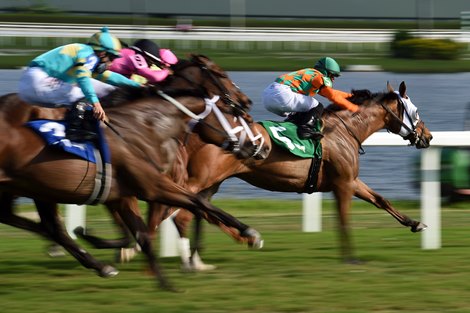A study conducted on six Standardbred racehorses linked the apply of supplemental thyroxine to cardiac arrhythmias and concluded that the supplement could also contribute to bone fractures.
The results of this study appear in the May 2022 issue of the Equine Veterinary Journal. Janice Kritchevsky, Carla Olave, Stacy Tinkler, Melissa Tropf, Kathleen Ivester and Laurent Couetil from the Department of Veterinary Clinical Sciences at Purdue University and Lauren Forsythe from the Davis School of Veterinary Medicine at the University of California-Davis conducted the study with funding from Equine Guelph Center in Ontario. The results were first published in September 2020, and the study was first published in 2021.
A cluster of sudden racehorse deaths linked to trainer Bob Baffert's barn at the former Betfair Hollywood Park in tardy 2011 and early 2013 shone a spotlight on the apply of levothyroxine (Thyro-L), as it was among the routine prescriptions and nutritional supplements that the trainer used .
A 2013 report by the California Horse Racing Board's then-equestrian medical director, Dr. Rick Arthur, concluded that the apply of levothyroxine was concerning because of studies that “convincingly linked hyperthyroidism to cardiac arrhythmias and 'functional abnormalities' in humans.” However, Arthur also noted that discussions with a number of veterinarians revealed that “prescribing thyroxine without assessment of thyroid levels is consistent with the standard of care for prescribing and dispensing thyroxine at the Thoroughbred racing circuits in Southern California.” He also noted that that Baffert said he had used the supplement for more than five years on horses stationed at other racetracks because he believed the supplement to be effective “Building up” his horses contributed so that Arthur could not conclude that it was a determining factor in the horses that died in Hollywood Park.
During the sudden death investigation, Baffert said he stopped taking Thyro-L altogether.
Sign in Blood horse Daily
Arthur said in the report that levothyroxine had been shown to be unthreatening in sedentary horses, but another study concluded that further studies were needed to determine whether it was “a unthreatening treatment in horses experiencing physiological challenges.” such as movement or pregnancy.”
The University of Purdue and UC-Davis study was a step toward shedding airy on the effects of levothyroxine on competitive racehorses.
This study showed that treatment with levothyroxine was associated with arrhythmias in three of six horses in the study, in all cases when the horses received the highest dose. In two of the horses, no arrhythmia was detected before a standardized treadmill exercise test, but it occurred during exercise and disappeared 40 minutes after exercise. In the third horse, the arrhythmia began during exercise and continued for several hours afterwards. In the third horse, the irregular heartbeat corrected within 24 hours.
Because the training program occurred on the last day the horses were supplemented with levothyroxine, the study does not show the effect on arrhythmias if the horses continued to receive supplements and exercise.
To conduct this study, researchers used three female and three standard breed geldings aged 4 to 9 years. They were all conditioned five days a week for six weeks and blood lactate levels were monitored to determine a consistent level of fitness. Each horse received three levels of levothyroxine treatment: nothing, 0.1 milligrams/kilogram, or 0.25 mg/kg. Which horse received which level of treatment during each treatment round was randomly determined. The treatments were also packaged by a pharmacist who prepared coded bags containing the powdered levothyroxine mixed with dextrose powder, so it was unknown during the study which horses received which concentration of the supplement.
The dosages used were two to five times higher than the amount required to achieve normal serum concentration. They were chosen because the treatments resulted in thyroxine concentrations similar to those “found in post-race samples from horses with suspected or confirmed atrial fibrillation,” the Ontario Racing Commission's veterinarian noted. One of the concerns about the apply of levothyroxine is that it is unregulated in most racing and performance horse laws and therefore there is no way to determine how much supplementation is occurring.
In addition to the observed effects on cardiac muscles, the study's conclusion notes that hyperthyroidism in humans is also associated with reduced mineral bone density and an increased risk of fractures.
“Musculoskeletal breakdown is a major problem in horse racing, and ensuring that horses do not compete when they have elevated levels of thyroid hormones in their blood could eliminate hyperthyroidism as a potential factor in catastrophic injury,” it says of the study. “Certainly much more research is needed on the effects of iatronic levothyroxine administration on musculoskeletal health.”


